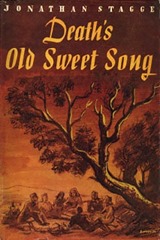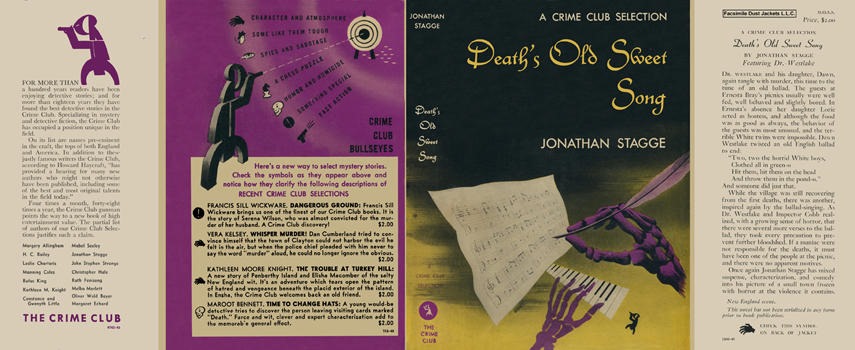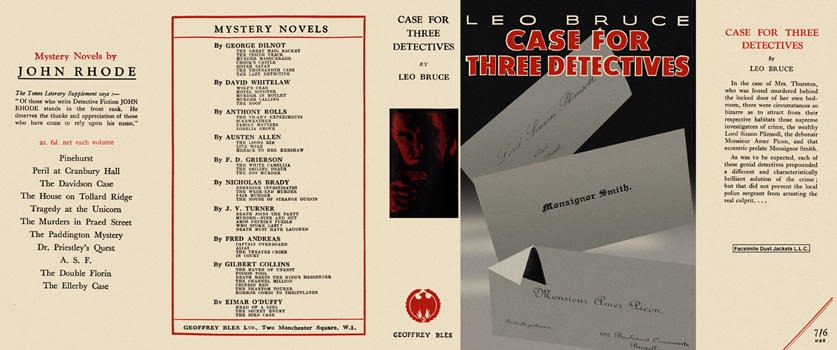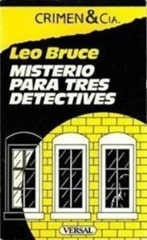Esta entrada es bilingüe. Desplazarse hacia abajo para acceder a la versión en español.
MysteriousPress.com/Open Road, 2018. Book Format: Kindle Edition. Print Length: 5678 KB. File Size: 233 pages. ASIN: B07CZ9FHZB. ISBN: 978-1-5040-5157-6. Originally published in the US for the Crime Club by Doubleday & Company, Inc. 1946. It was published in the UK by Michael Joseph, London, 1947.
A song holds the key to murder in this Dr. Hugh Westlake mystery from the Edgar Award–winning author who wrote the Peter Duluth series as Patrick Quentin.
 Book Description: Patrick Quentin, best known for the Peter Duluth puzzle mysteries, also penned outstanding detective novels from the 1930s through the 1960s under other pseudonyms, including Q. Patrick and Jonathan Stagge. Anthony Boucher wrote: “Quentin is particularly noted for the enviable polish and grace which make him one of the leading American fabricants of the murderous comedy of manners; but this surface smoothness conceals intricate and meticulous plot construction as faultless as that of Agatha Christie.”
Book Description: Patrick Quentin, best known for the Peter Duluth puzzle mysteries, also penned outstanding detective novels from the 1930s through the 1960s under other pseudonyms, including Q. Patrick and Jonathan Stagge. Anthony Boucher wrote: “Quentin is particularly noted for the enviable polish and grace which make him one of the leading American fabricants of the murderous comedy of manners; but this surface smoothness conceals intricate and meticulous plot construction as faultless as that of Agatha Christie.”
The affluent Bray family was known for throwing the most enjoyable picnics, and this one seemed to be no different to Dr Hugh Westlake and his precocious progeny, Dawn. When their host’s daughter breaks into a version of the old English folk ballad, “Green Grow the Rushes, O,” no one gives it a second thought. Little do they know the song portends death.
It begins with the bodies of twin boys found in the river, which connects to a lyric from the ballad. And before anyone can even recover from such a horror, more killings occur—all diabolically tied to the song. With help from Dawn and his old friend, Inspector Cobb, Westlake must sort through an ever-shrinking circle of suspects and stop a murderer from striking another deadly note.
My Take: Between 1936 and 1949, under the pen name of Jonathan Stagge, Richard Wilson Webb and Hugh Callingham Wheeler published a series of books featuring Dr Hugh Cavendish Westlake under Doubleday’s Crime Club imprint. Dr Westlake is a general practitioner in the small rural town of Kenmore –a fictional place in Buck County, Pa. He often finds himself involved in murder cases which he helps solve through his friendship with inspector Cobb, the chief of Police in the nearby town of Grovestown. Westlake is a widower who lives with his young daughter Dawn. Dawn is 10 years old in the first instalment and twelve in the book we are dealing with now. The series is made up of nine books. The first is The Dogs Do Bark (1936) AKA Murder Gone to Earth in the UK. The last, the only one written solo by Wheeler, is The Three Fears (1949). I became interested in these authors as a result of the Bodies from the Library 2021 Conference. Jonathan Stagge’s Death’s Old Sweet Song (1946) is the eighth instalment in the series and was among the suggested readings at the Conference. It is also one of the three books under the Jonathan Stagge moniker that are easily accessible. Its title makes reference to an old English ballad, Green Grow the Rushes-O, popular across the English-speaking world. The story is told by Dr Westlake himself in the first person and the action unfolds within a three days span.
 When the story opens, Dr Westlake and his twelve-year-old daughter, Dawn, had left their native Kenmore to vacation in neighbouring Skipton. They are heading towards the picnic that Mrs Ernesta Bray organizes every Saturday evening. On their way, Dawn gets on his father’s nerves repeating time and again the stanza of an old ballad she had picked up from Lorie Bray. “Two, two the lily-white boys,”. On arrival, they are greeted by Lorie, Ernesta’s twenty-year-old daughter, telling them she will act hostess this time in place of her mother, who has had to stay in New York this week end.
When the story opens, Dr Westlake and his twelve-year-old daughter, Dawn, had left their native Kenmore to vacation in neighbouring Skipton. They are heading towards the picnic that Mrs Ernesta Bray organizes every Saturday evening. On their way, Dawn gets on his father’s nerves repeating time and again the stanza of an old ballad she had picked up from Lorie Bray. “Two, two the lily-white boys,”. On arrival, they are greeted by Lorie, Ernesta’s twenty-year-old daughter, telling them she will act hostess this time in place of her mother, who has had to stay in New York this week end.
Amongst the guests are Phoebe Stone, Ernesta’s older sister; Caleb Stone, Phoebe’s young son, who has only been back from the Pacific war zone a month or so ago; Miss Love Drummond and her young nephews, the terrible twins Bobby and Billy White, whom she has not be able to left at home; Reverend Jessup, the community’s spiritual guide; Renton Forbes, the last of the Forbes who had been the leading family of Skipton for generations; and the Raynors, George and Mabel, who writes under the name of Avril Lane and prefers to be called Avril.
The picnic is interrupted when a rainstorm breaks out. The party splits with everyone running for cover. But not everyone makes it back home safely. The White twins have disappeared and when they are found they are dead in a pond, with a blow to the head. They have been murdered, bringing to everyone’s mind the lyrics in the song that says: ‘Two, two, the lily-white boys.’
From here onwards, the picnic participants will be chased one by one, and they will start appearing dead, following the lyrics of the song, in a similar way reminiscent of And Then There Were None by Agatha Christie.
‘What else can it be? The lily-white boys, the rivals, the gospel maker.’
‘And the knife – Ernesta’s paper knife. It proves it was one of us?’
Curtis Evans at The Passing Tramp defines this book as follows: ‘It’s not remotely realistic, when you really think about it, but it’s damned ingenious and the skill of the writing, in its setting and characterization, almost makes you believe in the plausibility of the mayhem.’ And I can’t agree more. As strange as it may seem, believable and unrealistic in equal parts. A brilliant novel I’ve very much enjoyed reading. Highly entertaining.
Suddenly at his Residence praises this book by saying: ‘This is entertainment through and through – it might not make sense in the moment, or seems incredibly ridiculous, but you don’t care. Its refreshing, and a breeze to read. You could describe it as a flight of fancy, and it is, but it’s a damn good one.’
Death’s Old Sweet Song has been reviewed, among others at The Passing Tramp (Curtis Evans), The Green Capsule, and at Suddenly at his Residence.

(Source: Facsimile Dust Jackets LLC. Doubleday The Crime Club (USA), 1946)
About the Author: Patrick Quentin, Q. Patrick and Jonathan Stagge were pen names under which Hugh Callingham Wheeler (19 March 1912 – 26 July 1987), Richard Wilson Webb (August 1901 – December 1966), Martha Mott Kelly (30 April 1906–2005) and Mary Louise White Aswell (3 June 1902 – 24 December 1984) wrote detective fiction. In some foreign countries their books have been published under the variant Quentin Patrick. Most of the stories were written by Webb and Wheeler in collaboration, or by Wheeler alone. Their most famous creation is the amateur sleuth Peter Duluth. In 1963, the story collection The Ordeal of Mrs. Snow was given a Special Edgar Award by the Mystery Writers of America.
Webb was born in Burnham-On-Sea, Somerset, and moved to the US in 1926, working as a researcher for a chemical company in Philadelphia. He became an American citizen in 1942. In 1931 he had started collaborating with Martha Mott Kelly, a partnership which produced two novels. The name’s origins, Q. Patrick, come from Martha Mott Kelley and Richard Wilson Webb’s names. Kelley was known as Patsy (Patsy Kelly was a well-known character actress of the period). Webb was known as Rick, so they came up with the name Q. Patrick. Patrick’s debut novel, called Cottage Sinister (published as Q. Patrick), was released in 1931. When Kelly got married, Webb found a new writing companion in Mary Louise Aswell, producing two more novels (in the meantime, he had written another novel all by himself). In 1936 Webb asked his old friend Hugh Wheeler, a Londoner who had moved to the US in 1934, to join him in developing a new series character, Peter Duluth. A Puzzle for Fools, the first novel in the “Peter Duluth” series and was released in 1936. Wheeler had attended the University of London, graduating with honours in 1933, and emigrating to the US in 1934. In 1942 he, too, became an American citizen, serving in the Army Medical Corps during WWII. During the late forties, Webb’s contributions decreased due to his health problems. All the “Patrick Quentin” novels from 1952 on were written by Wheeler alone. The authors’ series detectives include Peter Duluth, a theatrical producer, NY Homicide Lieutenant Timothy Trant, and (as Jonathan Stagge) Dr. Hugh Westlake, a small-town physician, and his daughter Dawn Westlake.
Jonathan Stagge’s novels: The Dogs Do Bark (1936) UK Title: Murder Gone to Earth (Webb and Wheeler); Murder by Prescription (1938) UK Title: Murder or Mercy (Webb and Wheeler); The Stars Spell Death (1939) UK Title: Murder in the Stars (Webb and Wheeler); Turn of the Table (1940) UK Title: Funeral for Five (Webb and Wheeler); The Yellow Taxi (1942) UK Title: Call a Hearse (Webb and Wheeler); The Scarlet Circle (1943) UK Title: Light from a Lantern (Webb and Wheeler); Death, My Darling Daughters (1945) UK Title: Death and the Dear Girls (Webb and Wheeler); Death’s Old Sweet Song (1946) (Webb and Wheeler); and The Three Fears (1949) (Wheeler). In bold the three books published by MysteriousPress.com/Open Road.
Mysterious Press publicity page
Open Road Media publicity page
Patrick Quentin page at Golden Age of Detective Fiction
The Jonathan Stagge Mysteries, Introduction
Verdes crecen los juncos, de Jonathan Stagge
Una canción es la clave del asesinato en este misterio del Dr. Hugh Westlake del autor ganador del premio Edgar que escribió la serie de Peter Duluth como Patrick Quentin.
 Descripción del libro: Patrick Quentin, más conocido por los enigmas de Peter Duluth, también escribió destacadas novelas policiacas a partir de la década de 1930 hasta los años 60 con otros seudónimos, incluidos Q. Patrick y Jonathan Stagge. Anthony Boucher escribió: “Quentin es particularmente conocido por su enviidiable perfección y elegancia que lo convierten en uno de los principales fabricantes estadounidenses de comedias de costumbres sobre asesinatos; pero esta suavidad superficial oculta una intrincada y meticulosa construcción de la trama tan impecable como la de Agatha Christie”.
Descripción del libro: Patrick Quentin, más conocido por los enigmas de Peter Duluth, también escribió destacadas novelas policiacas a partir de la década de 1930 hasta los años 60 con otros seudónimos, incluidos Q. Patrick y Jonathan Stagge. Anthony Boucher escribió: “Quentin es particularmente conocido por su enviidiable perfección y elegancia que lo convierten en uno de los principales fabricantes estadounidenses de comedias de costumbres sobre asesinatos; pero esta suavidad superficial oculta una intrincada y meticulosa construcción de la trama tan impecable como la de Agatha Christie”.
La acomodada familia Bray era conocida por organizar los picnics más entretenidos, y este no parecía diferente al Dr. Hugh Westlake y a su precoz hija, Dawn. Cuando la hija de su invitado irrumpe con una versión de la vieja balada folclórica inglesa, “Verdes crecen los juncos”, nadie le presta mayor importancia. Poco saben que la canción hace presagiar una muerte.
Comienza con los cuerpos de los gemelos encontrados en el río, hecho que se relaciona con una de las estrofas de la balada. Y antes incluso de que alguien pueda recuperarse de tal horror, se producen más asesinatos, todos diabólicamente vinculados con la canción. Con la ayuda de Dawn y su viejo amigo, el inspector Cobb, Westlake debe buscar entre un círculo cada vez más reducido de sospechosos y evitar que el asesino emita otra nota mortal.
Mi opinión: Entre 1936 y 1949, bajo el seudónimo de Jonathan Stagge, Richard Wilson Webb y Hugh Callingham Wheeler publicaron una serie de libros protagonizados por el Dr. Hugh Cavendish Westlake bajo el sello Crime Club de Doubleday. El Dr. Westlake es el médico de familia en la pequeña ciudad rural de Kenmore, un lugar ficticio en el condado de Buck, Pensilvania. A menudo se ve involucrado en casos de asesinato que ayuda a resolver gracias a su amistad con el inspector Cobb, el jefe de policía de la ciudad cercana de Grovestown. Westlake es un viudo que vive con su pequeña hija Dawn. Dawn tiene 10 años en la primera entrega y doce en el libro que nos ocupa ahora. La serie está compuesta por nueve libros. El primero es The Dogs Do Bark (1936) AKA Murder Gone to Earth en el Reino Unido. El último, el único escrito en solitario por Wheeler, es The Three Fears (1949). Me interesé por estos autores como resultado de la Conferencia Bodies from the Library 2021. Death’s Old Sweet Song (1946) de Jonathan Stagge es la octava entrega de la serie y fue una de las lecturas sugeridas en la Conferencia. También es uno de los tres libros bajo el nombre de Jonathan Stagge que son fáciles de conseguir. Su título hace referencia a una vieja balada inglesa, Green Grow the Rushes, O, popular en todo el mundo de habla inglesa. La historia la cuenta el propio Dr. Westlake en primera persona y la acción se desarrolla durante un lapso de tres días.
Cuando comienza la historia, el Dr. Westlake y su hija de doce años, Dawn, habían dejado su Kenmore natal para ir de vacaciones a la vecina Skipton. Se dirigen hacia el picnic que la Sra. Ernesta Bray organiza todos los sábados por la noche. En su camino, Dawn pone de los nervios a su padre repitiendo una y otra vez la estrofa de una vieja balada que había aprendido de Lorie Bray. “Two, two the lily-white boys,”. A su llegada, son recibidos por Lorie, la hija de veinte años de Ernesta, diciéndoles que esta vez actuará como anfitriona en lugar de su madre, que ha tenido que quedarse en Nueva York ese fin de semana.
Entre los invitados se encuentran Phoebe Stone, la hermana mayor de Ernesta; Caleb Stone, el hijo pequeño de Phoebe, que acaba de regresar del campo de batalla del Pacífico hace aproximadamente un mes; Miss Love Drummond y sus pequeños sobrinos, los terribles gemelos Bobby y Billy White, a quienes no ha podido dejar en casa; el reverendo Jessup, guía espiritual de la comunidad; Renton Forbes, el último de los Forbes que había sido la familia principal de Skipton durante generaciones; y los Raynor, George y Mabel, que escribe con el nombre de Avril Lane y prefiere que la llamen Avril.
El picnic se ve interrumpido cuando estalla una tormenta. La fiesta se divide y todos corren a refugiarse. Pero no todo el mundo vuelve a casa sano y salvo. Los gemelos White han desaparecido y cuando los encuentran están muertos en un estanque, con un golpe en la cabeza. Han sido asesinados, trayendo a la mente de todos la letra de la canción que dice: ‘Two, two, the lily-white boys.’
A partir de aquí, los participantes del picnic serán perseguidos uno a uno y comenzarán a aparecer muertos, siguiendo la letra de la canción, de manera similar a And Then There Were None de Agatha Christie.
‘’¿Qué otra cosa puede ser? Los niños blancos como el lirio, los rivales, los evangelistas”.
”Y el cuchillo, el cortapapeles de Ernesta. ¿Acaso no prueba esto que fue uno de nosotros?”
Curtis Evans en The Passing Tramp define este libro de la siguiente manera: “Cuando realmente piensas sobre ello, no es ni remotamente realista, pero es condenadamente ingenioso y la perfección de su redacción, en su escenario y caracterización, casi te hace creer en la credibilidad del caos.” Y no puedo estar más de acuerdo. Por extraño que parezca, creíble y poco realista a partes iguales. Una novela brillante que disfruté mucho leyendo. Muy entretenida.
Suddenly at his Residence elogia este libro diciendo: Esto es entretenimiento de principio a fin; puede que no tenga sentido en el momento, o que parezca increíblemente ridículo, pero no te importa. Es refrescante y muy fácil de leer. Se podría describir como un vuelo de la imaginación, y lo es, pero condenadamente bueno.
Acerca del autor: Patrick Quentin, Q. Patrick y Jonathan Stagge eran seudónimos bajo los cuales escribieron novelas policíacas Hugh Callingham Wheeler (19 de marzo de 1912 – 26 de julio de 1987), Richard Wilson Webb (agosto de 1901 – diciembre de 1966), Martha Mott Kelley (30 de abril de 1906 – 2005) y Mary Louise White Aswell (3 de junio de 1902-24 de diciembre de 1984). En algunos países extranjeros, sus libros se han publicado bajo la variante Quentin Patrick. La mayoría de las historias fueron escritas por Webb y Wheeler en colaboración, o por Wheeler solo. Su creación más famosa es el detective aficionado Peter Duluth. En 1963, la colección de cuentos The Ordeal of Mrs. Snow recibió un premio Edgar especial de Mystery Writers of America.
Webb nació en Burnham-On-Sea, Somerset, y se trasladó a los EE. UU. en 1926, para trabajar como investigador de una empresa química en Filadelfia. En 1942 se convirtió en ciudadano estadounidense. En 1931 comenzó a colaborar con Martha Mott Kelly, una asociación que generó dos novelas. Los orígenes del nombre, Q. Patrick, provienen de los nombres de Martha Mott Kelley y Richard Wilson Webb. Kelley era conocida como Patsy (Patsy Kelly era una conocida actriz de reparto de la época). Webb era conocido como Rick, por lo que se les ocurrió el nombre Q. Patrick. La primera novela de Patrick, llamada Cottage Sinister (publicada como Q. Patrick), fue editada en 1931. Cuando Kelly se casó, Webb encontró una nueva colaboradora en Mary Louise Aswell, publicando otras dos novelas (mientras tanto, había escrito otra novela en solitario). En 1936 Webb le pidió a su viejo amigo Hugh Wheeler, un londinense que se había mudado a los Estados Unidos en 1934, que se uniera a él en el desarrollo de un nuevo personaje de la serie, Peter Duluth. A Puzzle for Fools, la primera novela de la serie “Peter Duluth” fue publicada en 1936. Wheeler había estudiado en la Universidad de Londres, se graduó con honores en 1933 y emigró a los Estados Unidos en 1934. En 1942 él también se convirtió en ciudadano estadounidense, sirviendo en el Cuerpo Médico del Ejército durante la Segunda Guerra Mundial. A finales de los años cuarenta, las aportaciones de Webb disminuyeron debido a sus problemas de salud. Todas las novelas de “Patrick Quentin” a partir de 1952 fueron escritas solo por Wheeler. Las series de detectives de estos autores incluyen a Peter Duluth, un productor teatral, el teniente de homicidios de Nueva York Timothy Trant y (como Jonathan Stagge) el Dr. Hugh Westlake, un médico de un pueblo pequeño, y su hija Dawn Westlake.
Novelas como Jonathan Stagge: The Dogs Do Bark (1936) aka Murder Gone to Earth (Webb and Wheeler); Murder by Prescription (1938) aka Murder or Mercy [Crimen por receta (Editorial Hachette Buenos Aires, 1950)](Webb and Wheeler); The Stars Spell Death (1939) aka Murder in the Stars (Webb and Wheeler); Turn of the Table (1940) aka Funeral for Five (Webb and Wheeler); The Yellow Taxi (1942) aka Call a Hearse (Webb and Wheeler); The Scarlet Circle (1943) aka Light from a Lantern [El Círculo Escarlata (Editorial Aguilar)] (Webb and Wheeler); Death, My Darling Daughters (1945) aka Death and the Dear Girls [Muerte mis queridas hijas (Editorial Aguilar)] (Webb and Wheeler); Death’s Old Sweet Song (1946) [Verdes crecen los juncos (Editorial Aguilar)] (Webb and Wheeler); y The Three Fears (1949) (Wheeler).
Las Fascinantes Vidas de Patrick Quentin
















